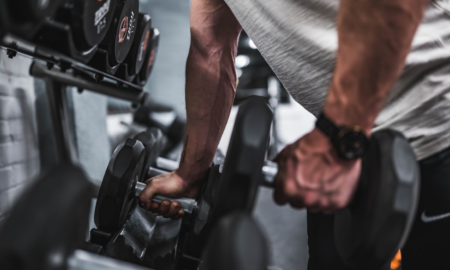

A great workout means more than individual exercises and muscle burn. It is the ability to efficiently burn fat and promote optimum functioning of muscles with as little effort as possible. Keep in mind, however, the robust process of creating a fitness routine is individualized and not a one-size-fits-all approach. Therefore, how far you typically reach is up to your mental frame of the ideal workout routine.
There are many valuable resources for fitness enthusiasts to build upon to adequately develop an effective workout routine. With that in mind, it is worth mentioning that incorporating a vast array of exercises to pick from makes it even harder to settle for a personalized routine. Put differently, a broader selection can force novice trainers to unintentionally use a hit-or-miss approach towards their fitness goals.
Variables like age, end-point objectives, diet, current shape, weight, flexibility, agility, and work schedule dictate your workout program.
How to Build a Fitness Routine
A customized workout schedule is the boiling point of fitness. Not only does personalizing workouts secure prime results for your effort, as the routine reflects your ability, but it is also easier to stick to the routine. If you are unfamiliar with fitness, there are some pointers to consider as you look for your unique rhythm:
Create an extensive list of feasible objectives
Candidly, a fitness program is one of the best ways of doing good for your health. Substantial activity is ideal for reducing the risk of long-term diseases, successful weight loss, improving agility and joint integrity, flooding the body with dopamine (the feel-good hormone), and more. In this manner, it is pivotal to carefully draft a routine with specific objectives.
In essence, you can start a fitness schedule if you comprehend what you are seeking to achieve. Are you looking to bulk? Perhaps induce your cardiovascular system? Or to build endurance and stamina?
There are diverse reasons to warrant a workout routine. In most cases, your key objectives should be realistic, achievable, and within your ability.
Consider your overall shape
Skilled athletes can whip a decent 2-hour run from nowhere because of muscle memory and endless training. The ideal scenario is equally applicable to powerlifters who devote most of their time bulking muscles and tuning their diet for intense energy-depleting lifts.
It is fundamental to rank your fitness into the three broad categories – beginner, intermediate, or professional. However, chances are you are experimenting with various programs and should start on low-intensity routines while aiming to gradually improve.
Create a comprehensive catalog of exercises suitable for your fitness level
When it comes to fitness, nothing is set in stone, and there are no limits to what you can achieve. Ideally, you go as far as you are fit and the constraints of fitness are broken by consistently working out. Notwithstanding, there are three primary classes of exercises:
- Cardio exercise – Any exercise that revs up the heart rate is a cardio workout. Cardio workouts are suitable for increasing stamina and resilience. As they introduce an immense demand on the heart and muscles, they also stimulate weight loss. Conversely, cardio workouts can double as suitable warmup exercises.

- Flexibility training – Gently stretching all the complex structures that move joints progressively improves the range of motion and the efficiency of movements apart from promoting recovery. Although flexibility training can be slotted on separate days, stretches should be part of your daily workout armory, particularly at the end of the routine.
- Weight training – Weight lifting is more effective in terms of weight loss and improving muscle strength and bulk.
How many sets and reps are ideal – beginner, intermediate, or pro?
It is critical to strike balance between the number of sets and reps with your proficiency. When starting, 8 reps of 2 to 3 sets are suitable. But as you scale the ladder to intermediate level, aim for 10 to 12 reps of 2 to 4 sets. Otherwise, if you are a professional, you hit comfortably 12 to 15 reps of 3 to 5 sets (or repeat consecutive sets until you are unable to do more).
Rest between sets and reps
In fitness, a set traditionally comprises an active session and a cool-down session to allow recovery. 30-second breaks at the end of each set are sufficient for recovery. More significantly, leading experts recommend resting a full day before reworking a muscle group, and at least two rest days in a week. If you exert maximum effort, it is common to still feel sore after an off-day. Therefore, you can have an extra day without losing rhythm.
Merging different routines for a superset
Be creative! As you are looking for a killer combination, shift gears between sets and include distinct variations of exercises. At the core of each set, aim to work out different groups of muscles as well as your cardiovascular system.
For example, a typical set can include lunges followed by squats or jumping jacks and burpees. Because a set comprises two exercises targeting other muscles, you can exercise one while the other is resting. Moreover, you don’t stop moving and your heart works harder during the routine.
How long to train; hours per day, days per week
A week has seven days, but you don’t need to work out non-stop. Muscles are destroyed during workouts and remodeled during rest. Allowing muscles enough time to recover and rest between workouts naturally stimulates growth while also preventing injury.
Therefore, target for at least three workout days per week with interspaced rest days.
Be consistent and progressively improve
Many people jump into fitness with enthusiasm and quit prematurely when muscles get sore. When starting, it is pivotal to start with low-intensity exercises while steadily increasing the intensity. To maintain improvement, you may need to increase the time spent exercising. Bottom line, after some time you will settle for the right routine for your key objectives.
After about one month, check whether you measure up to your fitness objectives when you initiated the program. However, if you lose motivation, set new goals or enlist the help of a fitness trainer.
Most important, be consistent and deliberate with your effort. It is straightforward to start a workout regimen but sticking to it is what counts. Therefore, plan carefully, pace yourself and establish a routine that lasts.
How to Cater Exercises to You
Maintaining a fulfilling lifestyle can be achieved by exercising. Keep in mind, however, that exercise is physical stress on the body, and how you manipulate the stress dictates the outcome. Therefore, an all-rounded program should factor:
- An assessment of the risks and benefits of each exercise.
- Sufficient variation in exercises while also adjusting intensity, repetition, sets, tempo, and recovery time.
- Ensuring consistency allows muscles and joints to further improve the range of motion, stability, and endurance.
- Modern trainers share challenging routines on YouTube and official websites and you can select one that optimally applies to your specific timelines and anticipated outcome.
- Equally, work your upper body as well as the lower half while sticking to traditional patterns of bodily movement: lunging, squatting, pushing, pulling, and rotating.
- Use free weights and machines as necessary as you gain more control of resistance.
- Incorporate activity into your ordinary routine and make plans for gradual improvement.
- To facilitate compliance to a greater degree yet, jot your routine on paper.
- Give yourself a break whenever necessary, ideally after a day of workouts.
Basic Training Guide/ Workout Schedule
It is harder for beginners to find the right combination of exercises to kickstart their fitness transformation. You may not know how hard to push to obtain maximum results while avoiding getting sore all over.
Fortunately, some basic elements come in handy when drafting a super routine. Such details include frequency, intensity, type, and time of workouts.
Frequency refers to the days in a week you get to work out. Ideally, your minimum target is three days a week featuring both cardio and strength training exercises. Intensity is your effort in workouts grouped in three scales; beginner, intermediate, and professional. Time is how long each session runs, with each expected to last between 30 minutes to one hour. Finally, the type is the exercises included in each session and includes cycling, running, and weight lifting.
When you draft your schedule based on these four principles, you will notice changes in body fat distribution, endurance, strength, and weight.
Design:
a) Warming up
Jumping jacks, boxer shuffle, side shuffles, torso twist with high knees, fly jacks, jogging, shoulder/ arm swings, butt kickers, side bends, side shuffles
b) Model exercises
Cardio – burpees, mountain climbers, jump squats, dive bombers with sit-throughs, plank jacks, side planks, stutter jacks, crunches
Weight training – weighted lunge, squats, Bulgarian splits, deadlifts, bicep curls, pushups, pullups, bench press, dumbbell rows, glute bridges, dumbbell rows
c) Cool down/ Flexibility exercises
Cat-cow position, pipe position, shell stretch, deep glutes stretch, lunging hamstring stretch, standing hamstring stretch, piriformis stretch, triceps stretch, figure-four stretch, butterfly stretch
How it all fits:
a) Beginner
Select three cardio and three weight training exercises. Each Do 8 to 10 reps of each exercise with two minutes between sets. After the rest, repeat each set twice before proceeding to your cool-down session.
- Warm-up (any four exercises: 45 seconds active, 15 seconds rest)
- (Cardio A, Rest, Cardio B, Rest, Cardio C, Rest) repeat twice
- (Weight A, Rest, Weight B, Rest, Weight C, Rest) repeat twice
- Cooldown
b) Intermediate
Pick three cardio and three weight exercises. Do 10 to 12 reps of each exercise with a minute’s rest between each set. Repeat 3 to 4 times before hitting your cool down.
- Warm-up (any five exercises: 50 seconds active, 10 seconds rest)
- (Cardio A, Rest, Cardio B, Rest, Cardio C, Rest) repeat 3 to 4 times
- (Weight A, Rest, Weight B, Rest, Weight C, Rest) repeat 3 to 4 times
- Cooldown
c) Pro
From the selection, choose your best four cardio and weight exercises. Hit 12 to 15 reps comprising 4 to 5 sets with one-minute rest between sets.
- Warm-up (any six exercises: full active minute back-to-back)
- (Cardio A, Rest, Cardio B, Rest, Cardio C, Rest, Cardio D, Rest) repeat 4 to 5 times
- (Weight A, Rest, Weight B, Rest, Weight C, Rest, Weight D, Rest) repeat 4 to 5 times
- Cooldown

d) Rest day
Walking, 30-minute to 1-hour cycle, flexibility exercises, yoga.
Always remember, your workout program should be centered around your life and specialized for your specific needs. In conclusion, here are a few basic workout tips that can aid you in your workout
Basic Working Out Tips
- Combine cardio with weight exercises – While cardio is effective in revving your heart and the circulatory system, scientists have shown that solitarily it is insufficient for weight loss. On the contrary, relying exclusively on cardio workouts, without the appropriate diet lowers metabolism and is therefore inefficient for weight loss. A Harvard study showed that lifting weight results in a higher elimination rate of abdominal fat, and with diet and cardio, your body show results.
- Create a workout playlist – Listening to music is intriguing. Music is central for pacing your rhythm while also promoting rapid recovery. Slow music after a workout floods the body with endorphins known to stimulate recovery.
3. Have a dynamic pre-workout warmup – Basic stretch routines are pivotal for avoiding injuries and activating muscles for intense workouts. Stimulated muscles and stretched-out ligaments are like a rubber band – once the neural mesh of the body notices increased activity, more blood is relayed to supply more oxygen and necessary nutrients boosting endurance and functionality.






















You must be logged in to post a comment Login